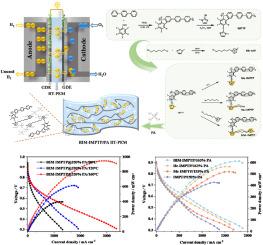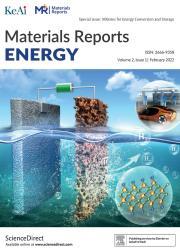PA-doped high-temperature proton exchange membranes containing bis-cation pairs with excellent PA retention capability for fuel cells
IF 13.8
引用次数: 0
Abstract
The thiol-imidazole functionalized (p-triphenyl-pentafluorobenzaldehyde) polymer (IMPTP) was prepared and quaternized with different side chains to obtain imidazolium-modified Me-IMPTP, He-IMPTP and BIM-IMPTP membranes for application in high-temperature proton exchange membrane fuel cells (HT-PEMFCs). The presence of the thioether group in the polymers enabled radical scavenging for antioxidant properties, while imidazolium cations interacted strongly with H2PO4− to prevent phosphoric acid (PA) leaching. The prepared BIM-IMPTP membrane incorporating bisimidazolium cation string with a long alkyl spacer demonstrated the highest mass retention of 82.93% after being immersed in Fenton's reagent for 24 h. Additionally, the PA-doped BIM-IMPTP membranes exhibited excellent PA retention under high-humidity conditions (80 °C/100% RH). The single cell equipped with the BIM-IMPTP/320%PA membrane achieved a maximum power density (PDmax) of 945 mW cm−2 at 160 °C. Among the four membranes with a similar acid doping content (ADC), the BIM-IMPTP/163%PA membrane with bis-cation pairs in the side chains exhibited a well-developed microphase-separated structure and high proton conductivity (119.0 mS cm−1 at 180 °C). The single cell assembled with BIM-IMPTP/163%PA membrane maintained a PDmax of 613 mW cm−2 at 160 °C and demonstrated long-term operational stability under both 150 °C/400 mA cm−2 and 80 °C/200 mA cm−2 conditions. These results indicate that the introduction of thioether and bis-cation pairs in the structural design of polymers contributes significantly to the long-term stability of HT-PEMs.

含双阳离子对的PA掺杂高温质子交换膜具有优异的PA保留性能
制备了巯基咪唑功能化(对三苯基五氟苯甲醛)聚合物(IMPTP),并进行了不同侧链的季铵化,得到了咪唑修饰的Me-IMPTP、He-IMPTP和bimm -IMPTP膜,用于高温质子交换膜燃料电池(ht - pemfc)。聚合物中硫醚基团的存在使自由基清除具有抗氧化性能,而咪唑阳离子与H2PO4−强相互作用以防止磷酸(PA)浸出。在Fenton试剂中浸泡24 h后,双咪唑阳离子链与长烷基间隔的BIM-IMPTP膜的质量保留率最高,为82.93%。此外,在高湿条件下(80°C/100% RH),掺杂PA的BIM-IMPTP膜具有良好的PA保留率。配备BIM-IMPTP/320%PA膜的单体电池在160℃下获得了945 mW cm - 2的最大功率密度(PDmax)。在四种酸掺杂含量(ADC)相似的膜中,侧链中含有双阳离子对的bimm - imptp /163%PA膜具有良好的微相分离结构和高质子电导率(180℃时为119.0 mS cm−1)。用bimimptp /163%PA膜组装的单细胞在160°C下保持613 mW cm - 2的PDmax,在150°C/400 mA cm - 2和80°C/200 mA cm - 2条件下均表现出长期的工作稳定性。这些结果表明,在聚合物结构设计中引入硫醚和双阳离子对对HT-PEMs的长期稳定性有重要贡献。
本文章由计算机程序翻译,如有差异,请以英文原文为准。
求助全文
约1分钟内获得全文
求助全文
来源期刊

材料导报:能源(英文)
Renewable Energy, Sustainability and the Environment, Nanotechnology
CiteScore
13.00
自引率
0.00%
发文量
0
审稿时长
50 days
 求助内容:
求助内容: 应助结果提醒方式:
应助结果提醒方式:


